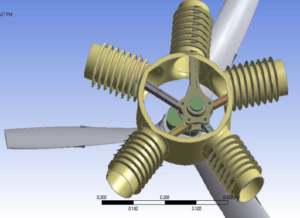
Anticipating Performance: Finite Element Method of the Structural Steel Connecting Rod in Radial Engines
The Connecting Rod, a sophisticated component within radial engines, undergoes rigorous stresses, including bending and torsion stress cycles, owing to the high loads it encounters. This study delves into a comprehensive parametric analysis of the Structural Steel Connecting Rod designed for a Four-Cylinder Radial Engine. Leveraging a 3D model of the Connecting Rod, symmetry is employed wherever feasible to streamline the analyses. Crucial parameters governing the one revolution of the Connecting Rod, such as Material, Rod End Diameters, Web Length, and Thickness, are meticulously examined.

The overarching goal of this research is to conduct Performance Forecasting for the Structural Steel Connecting Rod within a Radial Engine, employing the Finite Element Method (FEM). While acknowledging the computational intensity of a full Connecting Rod process simulation, the study emphasizes the practicality of employing simplified models for routine engineering work. Time, Total Deformation, Equivalent Stress, Equivalent Elastic Strain, Total Velocity, Joint Probable Force generation, Orientation of the Crank, and Total Acceleration emerge as the focal points of analysis. The research underscores that, with simplified models, these parameters can be accurately predicted, paving the way for enhanced efficiency in engineering workflows.

In the realm of FEM analysis, the study elevates our understanding of the Structural Steel Connecting Rod’s behavior under diverse conditions. The detailed examination of parameters such as Equivalent Stress and Equivalent Elastic Strain contributes to a nuanced comprehension of the structural integrity and performance of the Connecting Rod. The Finite Element Method, renowned for its precision in simulating complex mechanical systems, serves as a cornerstone in elucidating the dynamic response of the Connecting Rod to varying loads and conditions.
In conclusion, this research not only navigates the intricacies of parametric analysis for the Structural Steel Connecting Rod in Radial Engines but also highlights the significance of employing advanced computational methodologies. By FEM analysis, the study augments predictive capabilities, offering a valuable toolkit for engineers involved in the design and optimization of radial engine components. The findings derived from this research not only contribute to the field of mechanical engineering but also underscore the ongoing pursuit of efficiency and precision in the realm of complex component analysis.



